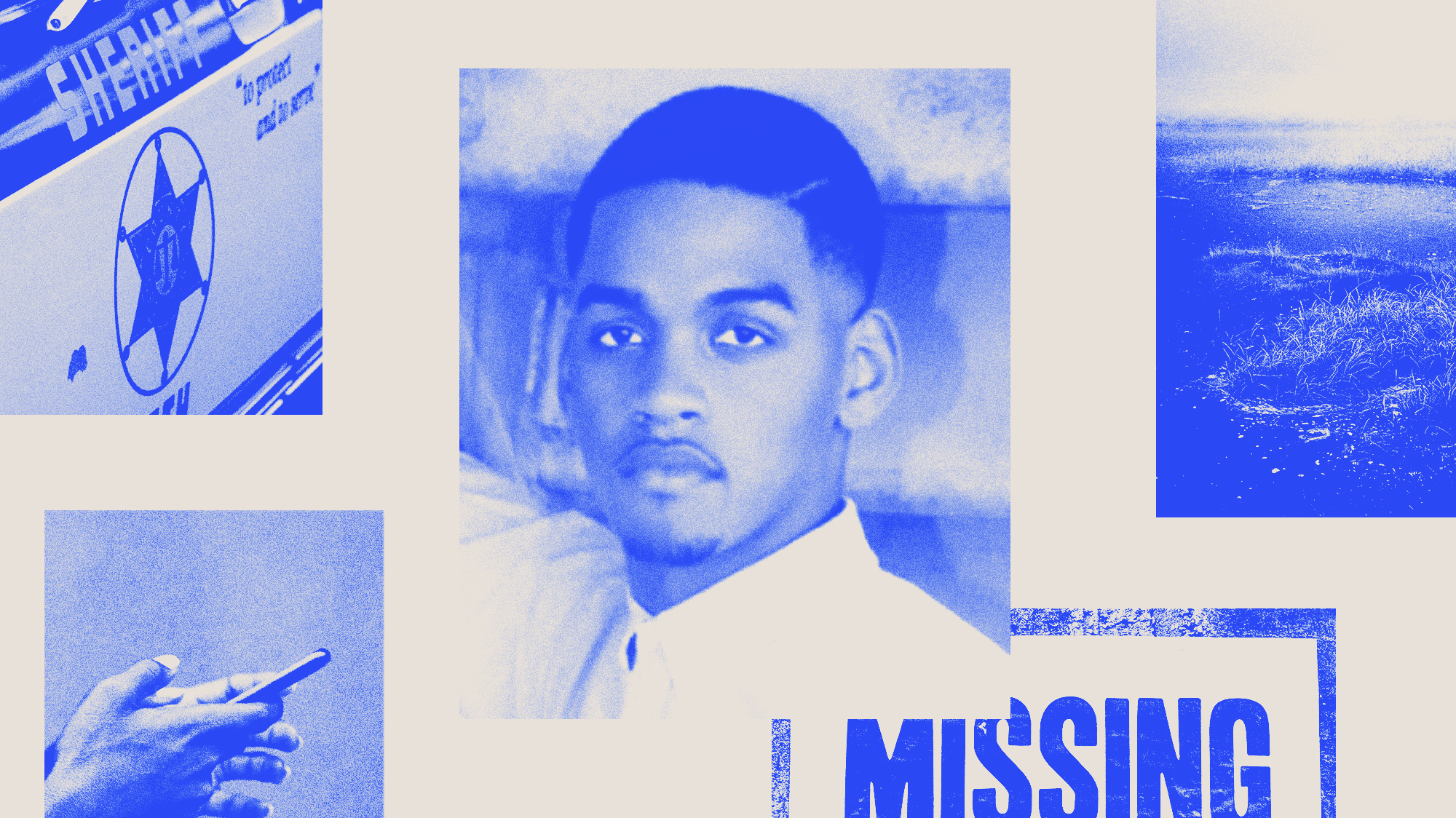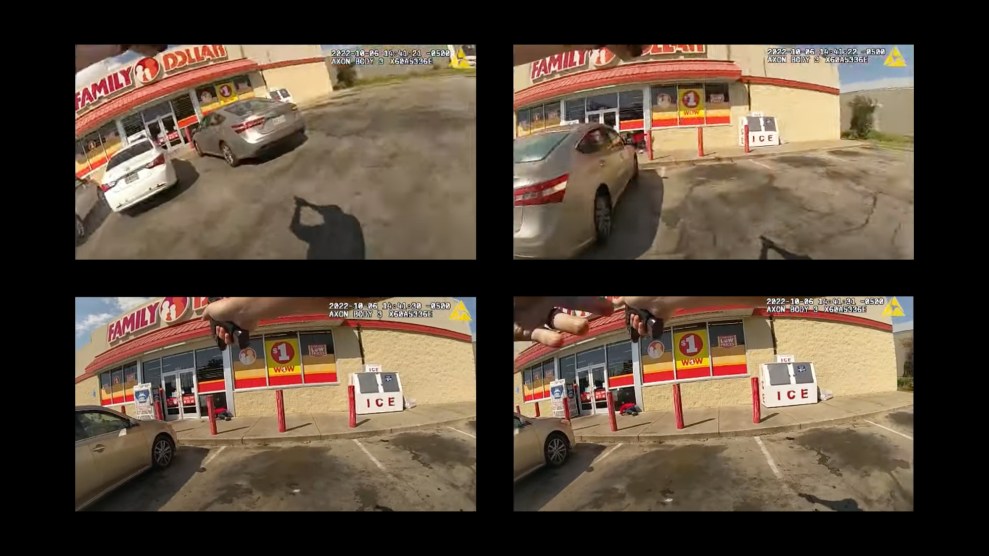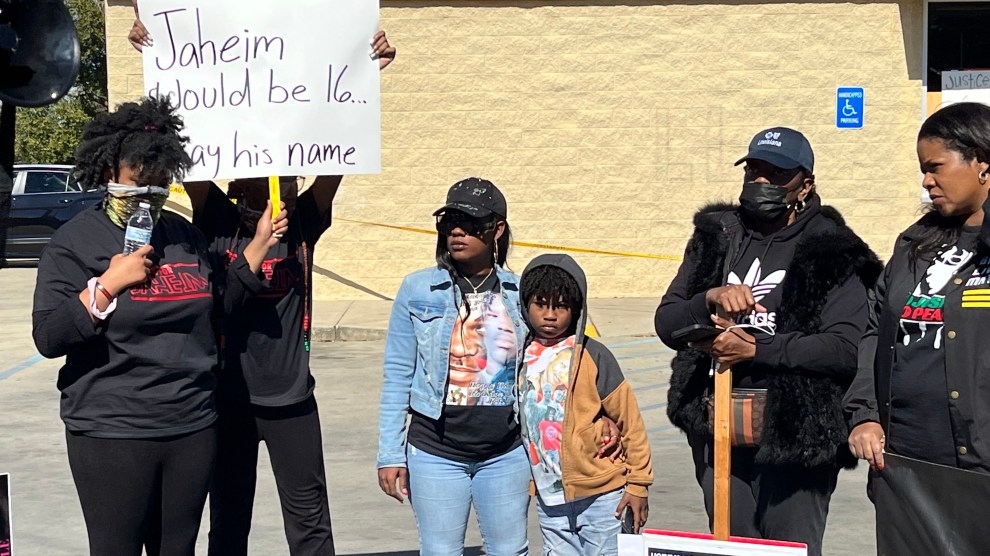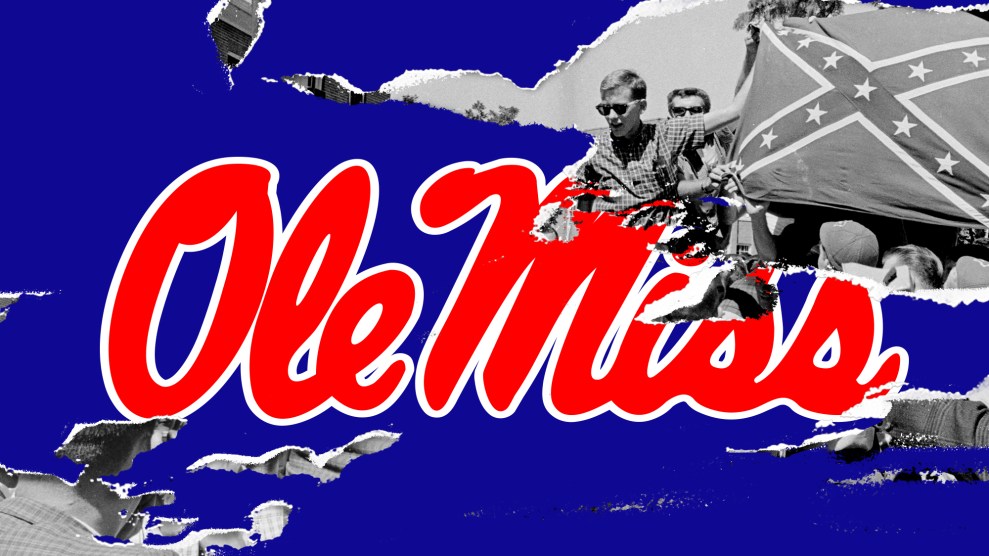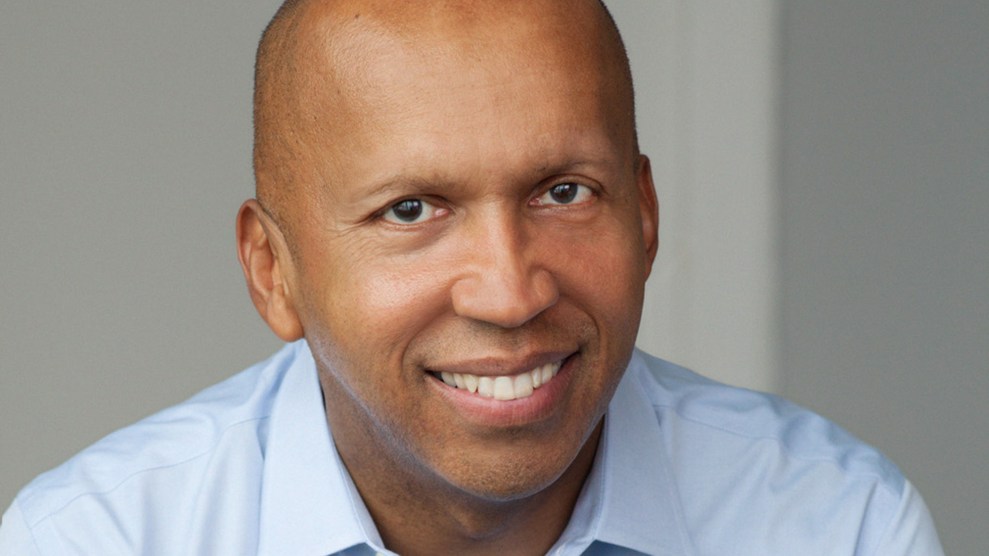On a Saturday in early October, Rasheem Carter, a 25-year-old Black man visiting rural Taylorsville, Mississippi, for work, called his mother in a panic. Some white guys were following him in three trucks, he said, and yelling racial slurs. He feared they would hurt him.
His mother, Tiffany Carter, who lived two hours away in the town of Fayette, stayed on the phone with her son as he went to the Taylorsville police station for help. She heard him tell the officers that he was being followed and ask them for a ride back to his hotel in Laurel, about 20 miles away. She heard an officer tell him no, because Laurel was out of their jurisdiction. She heard someone say he couldn’t stay at the station, that he had to leave.
The next morning, Carter, still frightened, returned to the police. Again, he felt as if the officers brushed him off. His mother sent a friend to pick him up, telling him to wait for the ride. But when the friend arrived, Carter had disappeared.
One month later, law enforcement discovered Carter dead in a wooded area near Taylorsville, on someone’s private property. There were very few remains: only his skull and a small number of his bones, along with his driver’s license and personal belongings like some clothes, a hotel room card, and an iPhone battery. The Smith County sheriff’s department announced the next day that it saw no signs of foul play.
The sheriff “tried to convince me that my son went back there,” Tiffany Carter recalls, “maybe hallucinating or high, and dehydrated and died.” She didn’t buy it: Carter was too smart to go wandering onto some white man’s land, she said, and he was trying to get out of Taylorsville, not hang around there. Plus, medical professionals told her it would typically take longer than 30 days for a body to decompose to bones. The sheriff suggested that buzzards and other wild animals ate her son’s flesh.
“What really had me baffled is, how can you clearly convey there is no foul play?” says Kendrick McDonald, a coroner in Fayette who also leads the local NAACP. “You cannot determine the cause or manner of any death without any thorough investigation.”
Skeptical, Carter’s family began working with a private investigator, who made several disturbing allegations, including that Carter’s bones were broken in smooth cuts, possibly inconsistent with an animal attack, and that his severed penis was found decomposed in his mouth. (The autopsy report refers to fractures but does not detail how clean the breaks were; it neither proves nor disproves the claims of genital mutilation, since the medical examiner received only bones.) Ben Crump, an attorney for the family who is nationally renowned for his work on police misconduct cases, says the skull contained no teeth. On top of everything else, the private investigator, whom the family declined to identify, claims that law enforcement mishandled the investigation and chose not to take Carter’s disappearance seriously, despite his earlier requests for help—allegations Smith County Sheriff Joel Houston denies. “We are addressing this [case] from every angle to get as many answers as we can for the family,” he told me. “If we find somebody who has anything to do with this, they’ll spend their day in court.”
For the most part, however, the cops have remained tight-lipped. The sheriff stopped returning my calls after an initial 15-minute interview in February, and other law enforcement agencies have ignored or denied my requests for comment, even as Carter’s family complains about a lack of transparency in the case. That silence has encouraged rumors: Kids in Taylorsville joke that a local resident fed Carter to his hogs. And some residents believe Police Chief Gabe Horn is related to the man who owns the property where Carter’s bones turned up—something Horn would not confirm or deny, since he wouldn’t speak with me. (I was unable to reach the property owner, but a Taylorsville resident who shares the owner’s last name told me that her family is related to the police chief, and that she suspects her family is also distantly related to the owner.)
But it’s not just a question of family—some of Horn’s other connections in the small town have also drawn attention.
According to a source familiar with Taylorsville and its residents, who requested anonymity for safety reasons, the chief recently started grabbing coffee most mornings at local restaurants with a group of white men he’s friendly with, at least one of whom has publicly made violent, racist comments about Carter and Black protesters in town. The group started meeting after Carter’s death and bills itself as a sort of literature club, according to the source; a restaurant employee, who could not recall whether Horn was a member of the group, told me she wasn’t sure what the club actually discussed—maybe because it wasn’t easy to hear them: “When they talk,” said the anonymous source, locals notice the men “are not talking out loud: They’re bent over the table whispering.”
Rasheem Carter arrived in Taylorsville in late September, less than a week before he disappeared on October 2. Back in Fayette, where his mother lived, he ran a seafood eatery called Cali’s Express, named after his seven-year-old daughter, that closed during the pandemic. But he had training as a welder and millwright and had come to Taylorsville to make some extra cash, snagging a short-term contract at a factory that processed wood from the region’s abundant pine forests.
As a Black man, he faced risks working there. The Ku Klux Klan is reportedly active in the county, and several Black Mississippians I spoke with described Taylorsville as a sundown town, saying they were afraid to be out after dark because of possible violence. The surrounding counties were historically a stronghold for white supremacists, according to William Sturkey, an associate professor at the University of North Carolina who studies the history of race in Mississippi and the South. The local KKK there “was probably the most violent anti-Black group” in the United States during the civil rights era, he says; in nearby Neshoba County, in a case that became nationally known as Mississippi Burning, white supremacists conspired to kill three civil rights workers in 1964 after teaming up with law enforcement.
Given that history, Carter may have been afraid to seek help from the cops; one of Taylorsville’s former police chiefs, who reportedly retired about a decade ago, posted a photo of himself on Facebook in a Confederate flag T-shirt, along with cover photos of the flag and Confederate leader Jefferson Davis. Today only a handful of police officers work in the town, most or all of them white.
Once inside the station, Carter gave a false name—“he was scared,” says his aunt Felica Kaho—introducing himself as Larry Duncan before asking for help. Carter told the officers about the white men in trucks and said he needed a ride to the Super 8 hotel in Laurel, too far to reach on foot; he normally rode with a coworker but couldn’t that evening. “It’s not common for a law enforcement agency to transport a citizen or anybody to another jurisdiction,” Sheriff Houston told me of the police’s decision to refuse Carter a lift. “We’re not a taxi service.”
It’s unclear where Carter spent the night, but he returned to the station early the next morning. The sheriff told me that officers invited Carter to wait there for a ride—something that his mother does not believe, since she’d heard them over the phone the evening before telling him he could not stay there. At some point, Carter asked the officers for directions back to Laurel and if he could borrow a charger for his iPhone, according to his family, who added that the police suggested he could find one at a gas station. (The sheriff said in November that officers offered Carter a charger, but it did not fit his phone.)
He left the police and called his mother shortly after 10 a.m., warning her that his phone battery only had 1 percent left. He said he was in a dollar store and dropped a pin to his location so her friend from another town could pick him up. By the time her friend arrived, around 1:30 p.m., Carter was gone.
In the days that followed, Carter’s family organized search parties. The dollar store’s management showed them surveillance video of Carter walking inside and then leaving. But owners at a nearby gas station and some other businesses did not share footage. They said they “rolled the cameras back and didn’t see him. How would you even know who you’re looking for?” says Kaho, Carter’s aunt. Carter went missing in broad daylight, she adds. “For nobody to see anything, I’m not believing it.”
At one point, the family encountered Taylorsville Police Officer Brad White inside a store and said they wanted to view more footage. White became defensive and suggested it wasn’t fair to imply the police were “covering up something,” according to the family and a TikTok video of the encounter, though he eventually allowed Carter’s mother to see the footage in question.
Meanwhile, Kaho asked the department if its officers searched for Carter too. She says they told her it was a small town, and that they’d driven around but saw no reason to look for Carter on foot. When Tiffany Carter first called the sheriff’s department, she says, its deputies had not yet been notified that her son was even missing. She says officers told her the family could continue looking for Carter as long as they stayed off private property.
Nearly a month later, a property owner in Taylorsville alerted law enforcement that he’d found an image on his hunting camera of a man he didn’t recognize walking on his land. It was Carter, and the photograph, according to Carter’s family, was taken around 4:25 p.m. the day he went missing. “He had no shirt on. It looked like he had been rolled in the dirt or his pants was wet,” said Kaho. “He had a stick on his shoulder that he was carrying. He was looking like somebody was chasing him.”
Law enforcement say they brought in cadaver dogs that found Carter’s body in a wooded area on the vast property. But they would not initially show Carter’s mother the remains—she wouldn’t receive them until February—or even photographs.
As she teamed up with a private investigator, other rumors surfaced. Some locals gossiped that Carter may have dated or flirted with the white daughter of a cop in town—a theory that could provide a motive for his death, and one that evokes memories of Emmett Till, the Black 14-year-old who was lynched in Mississippi after allegedly flirting with a white woman in 1955. Both the sheriff and Carter’s mother cast doubt on this explanation, given that Carter was only in Taylorsville for a handful of days, though Till, originally from Chicago, was also a visitor, in Mississippi for a week when he was kidnapped and tortured.
Before disappearing, Carter told his mother that a particular person he worked with posed a threat to him and should be a suspect if anything were to happen. The family also heard that someone withdrew money from Carter’s bank account two days after he went missing.
The sheriff’s department, which is leading the investigation alongside the police and the Mississippi Bureau of Investigation, pushed back against these theories. In November, Sheriff Houston told local reporters that investigators looked for evidence of a bank withdrawal, but that there was not yet proof of one. And this week he claimed Carter’s coworkers were not suspects because phone records and GPS coordinates showed their devices were far from Taylorsville on the day Carter went missing. “I want to dispel any rumors that are out there,” he told me in February. “There’s still a lot of unanswered questions.” He quickly said the private investigator’s claims that Carter’s genitals were mutilated were “nothing but a hoax,” but then added that it was impossible to know because only skeleton remained. “If you leave a dead animal out in the woods for a month,” he said, “you can imagine what buzzards and coyotes and whatnot would do to an animal. So it would be the same condition for a human.”
As for whether cops still saw no signs of foul play, he demurred: “I’ll leave that one for the Mississippi Bureau of Investigation to decide,” he told me. (The bureau declined to comment, citing the ongoing investigation.) After Carter’s family spoke at a press conference this week, the sheriff told a reporter at NBC News that law enforcement had not ruled out the possibility of homicide.
At a protest in December, Carter’s family heard another alarming story: that a young child in Taylorsville made a confession in school, about finding a body in their family’s hog pen. Later, a video circulated of an older student at a classroom podium, joking about Carter’s death. “The police turned him down, but [a local man’s] pigs didn’t,” the teenage boy says, as other students laugh. The boy describes how the man’s “pigs” were “chomping” on Carter’s legs and vomited his remains, which he says were then buried. “He’s got Rasheem’s body parts in his yard,” the boy adds, looking at someone in the classroom. “So FBI, y’all need to go search his house.” The children continue to giggle.
The video horrified Carter’s family, who wondered whether there might be any truth to it. “As a historian, I’m interested in the way that rumor and memory are operating here,” says Justin Randolph, an assistant professor at Texas State University who is writing a book about policing and white supremacy in Mississippi. “Absent hard evidence at present, the idea of children saying these gruesome, torturous things occurred could be coming from any number of places and people’s imaginations of what racial hate looks like,” as well as the understanding that “racial violence happens in the shadows nowadays.” Whereas public lynchings were common prior to the civil rights era, racial killings became more secretive starting in the 1960s, says Sturkey, the historian: White supremacists developed “a need to get rid of the body, because they by then gave a shit about what the rest of the world thought about them killing Black people,” he says. Around that time, “you see the Klan start to disappear people.”
When I tried to ask the Mississippi Bureau of Investigation about the hog rumors, a spokesperson declined to comment. When I tried to ask the police and the sheriff, they did not return my calls.
In February, Carter’s family organized another protest, and I traveled to Taylorsville to watch. A large group of law enforcement, most of them white, gathered across the street as the marchers, most of them Black, walked to the police station, demanding a better investigation. As the marchers returned afterward, a white man on the side of the road called out to them; I could not hear what he said, but protesters told me he made racist taunts. As they went to verbally confront him, several law enforcement officers flocked to the scene, telling the white man to stand back—”This is my territory right here!” he said—and urging the protesters to move on.
Afterward, another white man in Taylorsville, James Ainsworth, posted a now-deleted racist message on Facebook:
“[I]f they come back and threaten me again, I will be heeled and I will send the next black sons a bitch or bitches to see their hog ate brother in hell!!! I do promise everyone in this god forshaken land which I live in that!!! True talk white power!!!”
McDonald, the coroner and NAACP leader, heard that local KKK members began planning a retaliatory march, but none materialized. Ainsworth did not respond to my Facebook messages.
Chief Horn also posted a photo on Facebook after the protest, of a man hosing off some sidewalk chalk that said “Rasheem’s life mattered.” “Little clean up!!!” Horn wrote, along with a waving emoji. According to my anonymous source, Horn is believed to be friends with Ainsworth and the other white man at the protest, who have both joined the chief for morning coffee in recent months at some local restaurants. (A restaurant employee confirmed to me that a handful of older men meet regularly in a coffee club, but the employee did not recall who the members were. The employee expressed sympathy for Carter’s family, added that customers are asked not to gossip about the case, and requested I not name the restaurant, fearing repercussions for its business.)
At the protest, Horn stood in the road as the marchers passed. The large law enforcement presence behind him upset the family. The police had “people from Jones County, Forrest County, Newton County,” and even state troopers, “but you could not give my nephew a ride 22 miles away because it was out of your jurisdiction?” says Kaho, Carter’s aunt. “Everybody there that day crossed their jurisdiction and came to Taylorsville.”
“From the very first beginning, I don’t like how they handled this case,” says Tiffany Carter, who adds that obtaining evidence from local and state investigators has been like pulling teeth. “It’s really me against all of them.” After she received her son’s bones, as she prepared in February for his funeral, she felt so frustrated that she struggled to speak with me. “Nobody really gives a fuck about my son,” she said of the cops.
After the funeral, Carter’s family was notified that law enforcement found more remains in another location. As the state crime lab examined whether the bones could be Carter’s, the family thought of the video from the Taylorsville classroom, and the student who joked about more of Carter’s skeleton being buried in someone’s yard. They hoped an autopsy report from the first set of bones might provide clarity, but there were so few remains that it was hard to draw conclusions when it was released in early March: Carter’s skeleton was greasy, according to the report, and his family said it was covered with a sticky substance. Some of his bones were fractured at or near the time of death. A toxicology screening found no sign of drugs.
The medical examiner added that the decomposition of Carter’s body could have been caused by exposure to the elements, and that one or more animals gnawed on some of his remains, though whether they were wild critters or domesticated hogs is unclear. The cause and manner of death remain undetermined.
Independent medical experts I consulted said the speed at which a body becomes a skeleton can depend upon the weather conditions, taking anywhere from weeks to years. It’s possible for a person’s remains to skeletonize within 30 days, more likely during the summer, when temperatures are hot and the air is humid. One month “is pretty fast decomposition” given the temperatures in Taylorsville during October, when Carter died, says Daniel Wescott, who leads the Forensic Anthropology Center at Texas State University. But it was warm enough there, he adds, that “you can’t rule it out.” Other medical experts told me skeletons can also lose their teeth, as Carter’s did, due to natural decomposition.
On the heels of the autopsy report, another rumor emerged. In early March, a friend in Taylorsville told Carter’s family that a man had been arrested in the case, and that he was a former local law enforcement officer. For days, Carter’s aunt Kaho repeatedly called the sheriff to confirm the rumors, but she could not get through to him. The sheriff also did not return my calls, nor did police or Taylorsville’s city attorney, while the Mississippi Bureau of Investigations would not comment.
Whether or not the rumors are true, they tell us something about Smith County, Mississippi: that memories of historic, racist violence still loom large there, as does the modern-day threat of it. And that law enforcement’s reluctance to share information with Carter’s family or the public has fueled confusion, cynicism, and fear among the Black community. “What I learned,” says Tiffany Carter of local officials, “is that none of them could be trusted.”
Of the more than 4,400 American lynchings from 1877 to 1950, at least 654—about 1 in 7—took place in Mississippi, according to the Alabama-based Equal Justice Initiative. And from 2000 to 2021, according to a Washington Post investigation, there were at least eight suspected lynchings of Black men and teenagers in the state.
As Tiffany Carter and her loved ones wait for answers, they try to remember the good times they shared with Rasheem. At family parties, he would sometimes bring a seafood platter from his restaurant. He was generous, and they recall him donating school uniforms to kids who couldn’t afford their own at the start of the academic year. He loved music and dancing, and his daughter, Cali, his only child. “She’s the spitting image of her daddy,” says Kaho.
The girl, now 7, recently told her grandmother that she was grateful to at least get six good years with her father, whose death she is still struggling to process. “She said, ‘You know, grandma, I really hate what happened to my daddy,'” Tiffany Carter recalls. “To hear her say that at the age that she is, all I could tell her is, ‘I hate it too.'”
